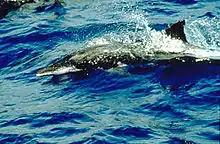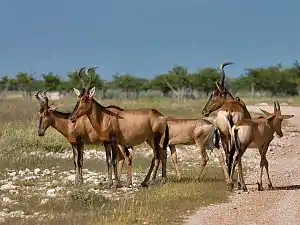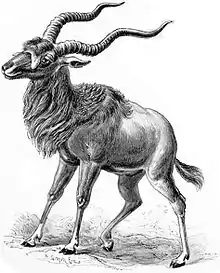This is a list of the mammal species recorded in Tunisia. Of the mammal species in Tunisia, three are critically endangered, three are endangered, nine are vulnerable, and two are near threatened. One of the species listed for Tunisia can no longer be found in the wild.[1]
The following tags are used to highlight each species' conservation status as assessed by the International Union for Conservation of Nature:
| EX | Extinct | No reasonable doubt that the last individual has died. |
| EW | Extinct in the wild | Known only to survive in captivity or as a naturalized populations well outside its previous range. |
| CR | Critically endangered | The species is in imminent risk of extinction in the wild. |
| EN | Endangered | The species is facing an extremely high risk of extinction in the wild. |
| VU | Vulnerable | The species is facing a high risk of extinction in the wild. |
| NT | Near threatened | The species does not meet any of the criteria that would categorise it as risking extinction but it is likely to do so in the future. |
| LC | Least concern | There are no current identifiable risks to the species. |
| DD | Data deficient | There is inadequate information to make an assessment of the risks to this species. |
Order: Macroscelidea (elephant shrews)
Often called sengis, the elephant shrews or jumping shrews are native to southern Africa. Their common English name derives from their elongated flexible snout and their resemblance to the true shrews.
- Family: Macroscelididae (elephant shrews)
- Genus: Elephantulus
- North African elephant shrew, E. rozeti LC
- Genus: Elephantulus
Order: Rodentia (rats and mice)
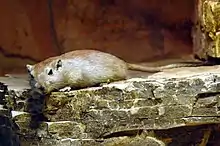
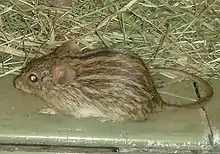
Rodents make up the largest order of mammals, with over 40% of mammalian species. They have two incisors in the upper and lower jaw which grow continually and must be kept short by gnawing. Most rodents are small though the capybara can weigh up to 45 kg (99 lb).
- Suborder: Hystricognathi
- Family: Hystricidae (Old World porcupines)
- Genus: Hystrix
- Crested porcupine, H. cristata LC[2]
- Genus: Hystrix
- Family: Hystricidae (Old World porcupines)
- Suborder: Sciurognathi
- Family: Gliridae (dormice)
- Subfamily: Leithiinae
- Genus: Eliomys
- Asian garden dormouse, E. melanurus LC[3]
- Genus: Eliomys
- Subfamily: Leithiinae
- Family: Dipodidae (jerboas)
- Subfamily: Dipodinae
- Genus: Jaculus
- Lesser Egyptian jerboa, Jaculus jaculus LC
- Greater Egyptian jerboa, Jaculus orientalis LC
- Genus: Jaculus
- Subfamily: Dipodinae
- Family: Muridae (mice, rats, voles, gerbils, hamsters, etc.)
- Subfamily: Gerbillinae
- Genus: Dipodillus
- North African gerbil, Dipodillus campestris LC
- Genus: Gerbillus
- Anderson's gerbil, Gerbillus andersoni LC
- Lesser Egyptian gerbil, Gerbillus gerbillus LC
- Pygmy gerbil, Gerbillus henleyi LC
- James's gerbil, Gerbillus jamesi DD
- Lataste's gerbil, Gerbillus latastei LC
- Balochistan gerbil, Gerbillus nanus LC
- Lesser short-tailed gerbil, Gerbillus simoni LC
- Tarabul's Gerbil, Gerbillus tarabuli LC
- Genus: Meriones
- Libyan jird, Meriones libycus LC
- Shaw's jird, Meriones shawi LC
- Genus: Pachyuromys
- Fat-tailed gerbil, Pachyuromys duprasi LC
- Genus: Psammomys
- Fat sand rat, Psammomys obesus LC
- Thin sand rat, Psammomys vexillaris DD
- Genus: Dipodillus
- Subfamily: Murinae
- Genus: Apodemus
- Wood mouse, Apodemus sylvaticus LC
- Genus: Lemniscomys
- Barbary striped grass mouse, Lemniscomys barbarus LC
- Genus: Mus
- Algerian mouse, Mus spretus LC
- Genus: Apodemus
- Subfamily: Gerbillinae
- Family: Ctenodactylidae
- Genus: Ctenodactylus
- Common gundi, Ctenodactylus gundi LC
- Genus: Ctenodactylus
- Family: Gliridae (dormice)
Order: Lagomorpha
Order: Erinaceomorpha (hedgehogs and gymnures)
The order Erinaceomorpha contains a single family, Erinaceidae, which comprise the hedgehogs and gymnures. The hedgehogs are easily recognised by their spines while gymnures look more like large rats.
- Family: Erinaceidae (hedgehogs)
- Subfamily: Erinaceinae
- Genus: Atelerix
- North African hedgehog, Atelerix algirus LC
- Genus: Hemiechinus
- Desert hedgehog, Hemiechinus aethiopicus DD
- Genus: Atelerix
- Subfamily: Erinaceinae
Order: Soricomorpha (shrews, moles, and solenodons)
The "shrew-forms" are insectivorous mammals. The shrews and solenodons closely resemble mice while the moles are stout-bodied burrowers.
- Family: Soricidae (shrews)
- Subfamily: Crocidurinae
- Genus: Crocidura
- Whitaker's shrew, Crocidura whitakeri LC
- Genus: Suncus
- Etruscan shrew, Suncus etruscus LC
- Genus: Crocidura
- Subfamily: Crocidurinae
Order: Chiroptera (bats)
The bats' most distinguishing feature is that their forelimbs are developed as wings, making them the only mammals capable of flight. Bat species account for about 20% of all mammals.
- Family: Vespertilionidae
- Subfamily: Myotinae
- Genus: Myotis
- Long-fingered bat, M. capaccinii VU[5]
- Geoffroy's bat, M. emarginatus LC[6]
- Felten's myotis, Myotis punicus DD
- Genus: Myotis
- Subfamily: Vespertilioninae
- Genus: Eptesicus
- Serotine bat, Eptesicus serotinus LC
- Genus: Hypsugo
- Savi's pipistrelle, H. savii LC[7]
- Genus: Otonycteris
- Desert long-eared bat, Otonycteris hemprichii LC
- Genus: Pipistrellus
- Kuhl's pipistrelle, Pipistrellus kuhlii LC
- Common pipistrelle, Pipistrellus pipistrellus LC
- Rüppell's pipistrelle, Pipistrellus rueppelli LC
- Genus: Eptesicus
- Subfamily: Miniopterinae
- Genus: Miniopterus
- Common bent-wing bat, M. schreibersii VU[8]
- Genus: Miniopterus
- Subfamily: Myotinae
- Family: Rhinopomatidae
- Genus: Rhinopoma
- Egyptian mouse-tailed bat, R. cystops LC[9]
- Lesser mouse-tailed bat, R. hardwickei LC
- Genus: Rhinopoma
- Family: Rhinolophidae
- Subfamily: Rhinolophinae
- Genus: Rhinolophus
- Blasius's horseshoe bat, R. blasii LC[10]
- Mediterranean horseshoe bat, R. euryale NT[11]
- Greater horseshoe bat, R. ferrumequinum LC[12]
- Lesser horseshoe bat, R. hipposideros LC[13]
- Mehely's horseshoe bat, R. mehelyi VU[14]
- Genus: Rhinolophus
- Subfamily: Hipposiderinae
- Genus: Asellia
- Trident leaf-nosed bat, Asellia tridens LC
- Genus: Asellia
- Subfamily: Rhinolophinae
Order: Cetacea (whales)
The order Cetacea includes whales, dolphins and porpoises. They are the mammals most fully adapted to aquatic life with a spindle-shaped nearly hairless body, protected by a thick layer of blubber, and forelimbs and tail modified to provide propulsion underwater.
- Suborder: Mysticeti
- Family: Balaenopteridae
- Genus: Balaenoptera
- Common minke whale, Balaenoptera acutorostrata LC
- Fin whale, Balaenoptera physalus VU
- Subfamily: Megapterinae
- Genus: Megaptera
- Humpback whale, Megaptera novaeangliae LC[15][16][17]
- Genus: Megaptera
- Genus: Balaenoptera
- Family: Balaenidae
- Genus: Eubalaena
- North Atlantic right whale, Eubalaena glacialis CR (possible)[18][19][20]
- Genus: Eubalaena
- Family: Balaenopteridae
- Suborder: Odontoceti
- Superfamily: Platanistoidea
- Family: Delphinidae (marine dolphins)
- Genus: Steno
- Rough-toothed dolphin, Steno bredanensis LC
- Genus: Delphinus
- Short-beaked common dolphin, Delphinus delphis EN
- Genus: Orcinus
- Orca, Orcinus orca DD
- Genus: Pseudorca
- False killer whale, Pseudorca crassidens DD
- Genus: Globicephala
- Long-finned pilot whale, Globicephala melas DD
- Genus: Grampus
- Risso's dolphin, Grampus griseus DD
- Genus: Stenella
- Striped dolphin, Stenella coeruleoalba VU
- Genus Tursiops
- Common bottlenose dolphin, Tursiops truncatus VU
- Genus: Steno
- Family Physeteridae (sperm whales)
- Genus: Physeter
- Sperm whale, Physeter catodon EN
- Genus: Physeter
- Family: Delphinidae (marine dolphins)
- Superfamily Ziphioidea (beaked whales)
- Family Ziphidae
- Genus: Ziphius
- Cuvier's beaked whale, Ziphius cavirostris LC
- Genus: Ziphius
- Family Ziphidae
- Superfamily: Platanistoidea
Order: Carnivora (carnivorans)

There are over 260 species of carnivorans, the majority of which feed primarily on meat. They have a characteristic skull shape and dentition.
- Suborder: Feliformia
- Family: Felidae (cats)
- Subfamily: Felinae
- Genus: Caracal
- Genus: Felis
- African wildcat, F. lybica LC[22]
- Genus: Leptailurus
- Subfamily: Felinae
- Family: Viverridae
- Subfamily: Viverrinae
- Genus: Genetta
- Common genet, G. genetta LC[24]
- Genus: Genetta
- Subfamily: Viverrinae
- Family: Herpestidae (mongooses)
- Genus: Herpestes
- Egyptian mongoose, H. ichneumon LC[25]
- Genus: Herpestes
- Family: Hyaenidae (hyaenas)
- Genus: Hyaena
- Striped hyena, H. hyaena NT[26]
- Genus: Hyaena
- Family: Felidae (cats)
- Suborder: Caniformia
- Family: Canidae (dogs, foxes)
- Genus: Canis
- African golden wolf, C. lupaster LC[27]
- Genus: Vulpes
- Rüppell's fox, V. rueppellii LC[28]
- Red fox, V. vulpes LC[29]
- Fennec fox, V. zerda LC[30]
- Genus: Canis
- Family: Mustelidae (mustelids)
- Genus: Ictonyx
- Saharan striped polecat, Ictonyx libyca LC[31]
- Genus: Lutra
- Eurasian otter, L. lutra NT[32]
- Genus: Ictonyx
- Family: Phocidae (earless seals)
- Genus: Monachus
- Mediterranean monk seal, M. monachus EN possibly extirpated[33]
- Genus: Monachus
- Family: Canidae (dogs, foxes)
Order: Artiodactyla (even-toed ungulates)
The even-toed ungulates are ungulates whose weight is borne about equally by the third and fourth toes, rather than mostly or entirely by the third as in perissodactyls. There are about 220 artiodactyl species, including many that are of great economic importance to humans.
- Family: Suidae (pigs)
- Family: Cervidae (deer)
- Subfamily: Cervinae
- Genus: Cervus
- Red deer, C. elaphus LC
- Barbary stag, C. e. barbarus
- Red deer, C. elaphus LC
- Genus: Cervus
- Subfamily: Cervinae
- Family: Bovidae (cattle, antelope, sheep, goats)
- Subfamily: Antilopinae
- Genus: Gazella
- Cuvier's gazelle, G. cuvieri VU[35]
- Dorcas gazelle, G. dorcas EN
- Rhim gazelle, G. leptoceros EN
- Genus: Gazella
- Subfamily: Caprinae
- Genus: Ammotragus
- Barbary sheep, A. lervia VU
- Genus: Ammotragus
- Subfamily: Hippotraginae
- Genus: Oryx
- Scimitar oryx, O. dammah EW vagrant
- Genus: Oryx
- Subfamily: Antilopinae
Extinct
The following species are locally extinct in the country:
- Addax, Addax nasomaculatus.[36] Though the last animal disappeared in 1932, it has been successfully reintroduced since 2007 from specimens from Niger and others kept in zoos. It was able to reproduce in the wild and even able to multiply outside of the fenced enclosure of the large national park where it had been reintroduced.[37]
- Hartebeest, Alcelaphus buselaphus[38]
- Aurochs, Bos primigenius[39]
- North African elephant, Loxodonta africana pharaohensis[40]
- Barbary macaque, Macaca sylvanus[41]
- Dama gazelle, Nanger dama[42]
- Lion, Panthera leo[43]
- Leopard, Panthera pardus[44]
- Brown bear, Ursus arctos[45]
See also
References
- ↑ This list is derived from the IUCN Red List which lists species of mammals and includes those mammals that have recently been classified as extinct (since 1500 AD). The taxonomy and naming of the individual species is based on those used in existing Wikipedia articles as of 21 May 2007 and supplemented by the common names and taxonomy from the IUCN, Smithsonian Institution, or University of Michigan where no Wikipedia article was available.
- ↑ Grubb, P.; Amori, G.; de Smet, K. & Bertolino, S. (2010). "Hystrix cristata". IUCN Red List of Threatened Species. 2010: e.T10746A3211666.
- ↑ Amori, G.; Aulagnier, S.; Hutterer, R.; Kryštufek, B.; Yigit, N.; Mitsain, G. & Palomo, L.J. (2016). "Eliomys melanurus". IUCN Red List of Threatened Species. 2016: e.T7619A115085446.
- ↑ Johnston, C.H.; Robinson, T.J.; Child, M.F. & Relton, C. (2019). "Lepus capensis". IUCN Red List of Threatened Species. 2019: e.T41277A45186750.
- ↑ Hutson, A. M.; Spitzenberger, F.; Aulagnier, S.; Juste, J.; Karatas, A.; Palmeirim, J. & Paunovic, M. (2010). "Myotis capaccinii". IUCN Red List of Threatened Species. 2010: e.T14126A4399043.
- ↑ Piraccini, R. (2016). "Myotis emarginatus". IUCN Red List of Threatened Species. 2016: e.T14129A22051191.
- ↑ Hutson, A. M.; Spitzenberger, F.; Juste, J.; Aulagnier, S.; Palmeirim, J.; Paunovic, M. & Karatas, A. (2010). "Hypsugo savii". IUCN Red List of Threatened Species. 2010: e.T44856A10955205.
- ↑ Gazaryan, S.; Bücs, S. & Çoraman, E. (2020). "Miniopterus schreibersii". IUCN Red List of Threatened Species. 2020: e.T81633057A151216401.
- ↑ Benda, P. (2017). "Rhinopoma cystops". IUCN Red List of Threatened Species. 2017: e.T82345555A82345569.
- ↑ Taylor, P. (2016). "Rhinolophus blasii". IUCN Red List of Threatened Species. 2016: e.T19515A21972073.
- ↑ Juste, J. & Alcaldé, J. (2016). "Rhinolophus euryale". IUCN Red List of Threatened Species. 2016: e.T19516A21971185.
- ↑ Piraccini, R. (2016). "Rhinolophus ferrumequinum". IUCN Red List of Threatened Species. 2016: e.T19517A21973253.
- ↑ Taylor, P. (2016). "Rhinolophus hipposideros". IUCN Red List of Threatened Species. 2016: e.T19518A21972794.
- ↑ Alcaldé, J.; Benda, P. & Juste, J. (2016). "Rhinolophus mehelyi". IUCN Red List of Threatened Species. 2016: e.T19519A21974380.
- ↑ Notarbartolo di Sciara G. (2002). "Cetacean Species Occurring in the Mediterranean and Black Seas" (PDF). Cetaceans of the Mediterranean and Black Seas: State of Knowledge and Conservation Strategies. A Report to the ACCOBAMS Secretariat, Monaco. Istituto Centrale per la Ricerca Applicata al Mare and the ACCOBAMS: 1–18. Retrieved 2016-04-16.
- ↑ "Are humpback whales electing the Mediterranean Sea as new residence?". Retrieved 2022-05-08.
- ↑ http://www.pelagosinstitute.gr/en/pelagos/pdfs/mediterranean_megaptera.pdf
- ↑ COSEWIC Assessment and Status Report on the North Atlantic Right Whale Eubalaena glacialis in Canada - 2013- Wildlife Species Description and Significance
- ↑ "WhaleNet Information Archive 1997: Right whale sighting in the Mediterranean Sea (fwd)". Archived from the original on 2016-03-05. Retrieved 14 May 2015.
- ↑ Monsarrat S.; Pennino G. M.; Smith D. T.; Reeves R.R.; Meynard N. C.; Kaplan M. D.; Rodrigues L. S. A. (2015). "Historical summer distribution of the endangered North Atlantic right whale (Eubalaena glacialis): a hypothesis based on environmental preferences of a congeneric species" (PDF). Diversity and Distributions. 21 (8): 925–937. doi:10.1111/ddi.12314. S2CID 53593157. Retrieved 2016-04-20.
- ↑ Avgan, B.; Henschel, P. & Ghoddousi, A. (2016). "Caracal caracal". IUCN Red List of Threatened Species. 2016: e.T3847A102424310.
- ↑ Ghoddousi, A.; Belbachir, F.; Durant, S.M.; Herbst, M. & Rosen, T. (2022). "Felis lybica". IUCN Red List of Threatened Species. 2022: e.T131299383A154907281. doi:10.2305/IUCN.UK.2022-1.RLTS.T131299383A154907281.en.
- ↑ Thiel, C. (2015). "Leptailurus serval". IUCN Red List of Threatened Species. 2015: e.T11638A50654625.
- ↑ Gaubert, P.; Carvalho, F.; Camps, D. & Do Linh San, E. (2015). "Genetta genetta". IUCN Red List of Threatened Species. 2015: e.T41698A45218636.
- ↑ Do Linh San, E.; Maddock, A.H.; Gaubert, P. & Palomares, F. (2016). "Herpestes ichneumon". IUCN Red List of Threatened Species. 2016: e.T41613A45207211.
- ↑ AbiSaid, M. & Dloniak, S.M.D. (2015). "Hyaena hyaena". IUCN Red List of Threatened Species. 2015: e.T10274A45195080.
- ↑ Hoffmann, M. & Atickem, A. (2019). "Canis lupaster". IUCN Red List of Threatened Species. 2019: e.T118264888A118265889.
- ↑ Mallon, D.; Murdoch, J.D. & Wacher, T. (2015). "Vulpes rueppelli". IUCN Red List of Threatened Species. 2015: e.T23053A46197483.
- ↑ Hoffmann, M. & Sillero-Zubiri, C. (2016). "Vulpes vulpes". IUCN Red List of Threatened Species. 2016: e.T23062A46190249.
- ↑ Wacher, T.; Bauman, K. & Cuzin, F. (2015). "Vulpes zerda". IUCN Red List of Threatened Species. 2015: e.T41588A46173447.
- ↑ Ahmim, M. & Do Linh San, E. (2015). "Ictonyx libyca". IUCN Red List of Threatened Species. 2015: e.T41645A45212347.
- ↑ Roos, A.; Loy, A.; de Silva, P.; Hajkova, P. & Zemanová, B. (2015). "Lutra lutra". IUCN Red List of Threatened Species. 2015: e.T12419A21935287.
- ↑ Karamanlidis, A. & Dendrinos, P. (2015). "Monachus monachus". IUCN Red List of Threatened Species. 2015: e.T13653A45227543.
- ↑ Keuling, O. & Leus, K. (2019). "Sus scrofa". IUCN Red List of Threatened Species. 2019: e.T41775A44141833.
- ↑ IUCN SSC Antelope Specialist Group (2016). "Gazella cuvieri". IUCN Red List of Threatened Species. 2016: e.T8967A50186003.
- ↑ IUCN SSC Antelope Specialist Group (2016). "Addax nasomaculatus". IUCN Red List of Threatened Species. 2016: e.T512A50180603.
- ↑ Tania Gilbert, Tim Woodfine, Marie Petretto, Mohamed Nouioui, Bill Houston, Philip Riordan. "Reintroduction of addax to Djebil National Park,Tunisia". In Book: Re-introduction of Addax to Djebil National Park, Tunisia. In: Global Reintroduction Perspectives: 2018. Case Studies from Around the Globe. (Ed. P.S.Soorae) Publisher: IUCN/SSC Re-introduction Specialist Group and Environment Agency-Abu Dhabi: 120.
{{cite journal}}: CS1 maint: multiple names: authors list (link) - ↑ IUCN SSC Antelope Specialist Group (2019). "Alcelaphus buselaphus". IUCN Red List of Threatened Species. 2019: e.T811A143160967.
- ↑ "Stone Age tools and animal bones in Tunisia are 'clues to an early human corridor'". ox.ac.uk. Retrieved 14 March 2017.
- ↑ Ham, Anthony; Hole, Abigail (2004). Tunisia. Lonely Planet Publications.
- ↑ Wallis, J.; Benrabah, M.E.; Pilot, M.; Majolo, B. & Waters, S. (2020). "Macaca sylvanus". IUCN Red List of Threatened Species. 2020: e.T12561A50043570.
- ↑ IUCN SSC Antelope Specialist Group (2016). "Gazella dama". IUCN Red List of Threatened Species. 2016: e.T8968A50186128.
- ↑ Bauer, H.; Packer, C.; Funston, P. F.; Henschel, P. & Nowell, K. (2016). "Panthera leo". IUCN Red List of Threatened Species. 2016: e.T15951A115130419.
- ↑ Stein, A.B.; Athreya, V.; Gerngross, P.; Balme, G.; Henschel, P.; Karanth, U.; Miquelle, D.; Rostro-Garcia, S.; Kamler, J. F.; Laguardia, A.; Khorozyan, I. & Ghoddousi, A. (2020). "Panthera pardus". IUCN Red List of Threatened Species. 2020: e.T15954A163991139.
- ↑ McLellan, B. N.; Proctor, M. F.; Huber, D. & Michel, S. (2017). "Ursus arctos". IUCN Red List of Threatened Species. 2017: e.T41688A121229971.
External links
- "Animal Diversity Web". University of Michigan Museum of Zoology. 1995–2006. Retrieved 22 May 2007.
